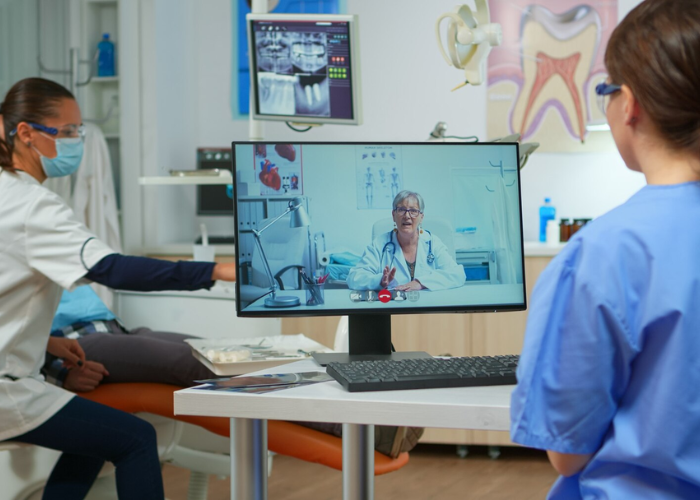In today’s fast-paced digital world, the Virtual Dental Receptionist industry is evolving to keep up with technological advancements designed to improve patient care. At the forefront of this transformation is the virtual dental receptionist—a game-changer in how dental practices manage their operations and patient interactions. But what truly sets this innovative approach apart? In this blog post, we’ll uncover the numerous benefits and practical applications of virtual dental receptionists, exploring how they can streamline your practice, enhance patient experience, and even increase profitability.
Join us as we take a closer look at the future of dental practice management and how these virtual assistants can contribute to a more efficient and engaging experience for everyone involved.
The Rise of Virtual Dental Receptionists
Virtual dental receptionists are becoming increasingly popular in dental practices worldwide. These digital assistants are equipped with advanced AI capabilities, making them a valuable resource for managing day-to-day tasks. While traditional receptionists have served their purpose, the rise of virtual assistants can be attributed to their ability to operate round the clock without fatigue or human error.
The integration of virtual dental receptionists is not just a trend—it’s a revolution in patient care. With constant advancements in AI, virtual receptionists can now handle a myriad of tasks, from appointment scheduling to answering patient queries. This shift not only frees up time for dental professionals but also ensures that no patient inquiry goes unanswered, leading to improved patient satisfaction.
Furthermore, the cost-effectiveness of virtual dental receptionists cannot be overstated. Unlike human employees, they do not require salaries, benefits, or breaks, thereby reducing operational costs significantly. This financial advantage allows dental practices to allocate resources to other areas, such as advanced treatment options or enhanced patient amenities.
How Virtual Receptionists Work
At their core, virtual dental receptionists function through sophisticated AI algorithms and machine learning capabilities. These technologies enable them to understand and respond to patient inquiries effectively, mimicking the interaction of a human receptionist. They are programmed to handle a wide range of tasks, including appointment scheduling, reminder notifications, and answering frequently asked questions.
One of the key features of virtual receptionists is their ability to integrate seamlessly with existing dental software systems. This integration allows them to access patient records, update appointments, and gather necessary information without disrupting the workflow. By automating these processes, dental practices can maintain an organized and efficient system that benefits both staff and patients.
Another crucial aspect of virtual receptionists is their adaptability. They can be customized to meet the specific needs of each dental practice, ensuring that their functions align with the unique operational requirements and patient demographics. This flexibility allows practices to tailor their virtual receptionist services to provide a personalized experience for patients while maintaining consistency and accuracy.
Streamlining Appointment Scheduling
One of the most significant challenges faced by dental practices is managing appointment scheduling efficiently. With a virtual dental receptionist, this task becomes seamless and hassle-free. By leveraging AI technology, virtual receptionists can schedule appointments based on availability, patient preferences, and urgency of care, ensuring that every patient receives the attention they need.
Virtual receptionists can also send automated reminders to patients, reducing the likelihood of missed appointments or last-minute cancellations. This proactive approach helps maintain a steady flow of patients throughout the day, minimizing downtime and maximizing productivity for dental professionals. Furthermore, by offering real-time scheduling updates, virtual receptionists ensure that the practice’s schedule remains accurate and up-to-date.
Integrating virtual receptionists into appointment scheduling processes enhances patient satisfaction by providing a convenient and accessible means of communication. Patients can book or reschedule appointments without waiting on hold or speaking with a human receptionist, offering greater flexibility and control over their dental care.
Enhancing Patient Communication
Effective communication is the backbone of any successful dental practice. Virtual dental receptionists play a vital role in maintaining clear and consistent communication with patients. By handling inquiries and providing essential information, virtual receptionists ensure that patients feel informed and valued throughout their dental care journey.
Virtual receptionists are equipped to handle various communication channels, including phone calls, emails, and online chat platforms. This multi-channel approach allows patients to reach out through their preferred method, enhancing accessibility and convenience. By providing prompt and accurate responses, virtual receptionists build trust and rapport with patients, contributing to a positive overall experience.
Additionally, virtual receptionists can assist in managing patient feedback and reviews. By encouraging patients to share their experiences, practices can identify areas for improvement and celebrate successes. This feedback loop helps practices maintain high standards of care and continuously enhance the patient experience.
Improving Operational Efficiency
One of the primary benefits of incorporating a virtual dental receptionist is the improvement in operational efficiency. By automating routine tasks, virtual receptionists free up time for dental staff to focus on more complex responsibilities. This shift in workload allows practices to optimize their resources and deliver exceptional patient care.
Virtual receptionists can manage patient records, update databases, and generate reports, reducing the administrative burden on dental staff. By streamlining these processes, practices can ensure that patient information is accurate, up-to-date, and easily accessible, enhancing overall efficiency and productivity.
Furthermore, virtual receptionists can assist in inventory management by tracking supplies and notifying staff when stock levels are low. This proactive approach prevents shortages and ensures that practices have the necessary materials to provide uninterrupted care.
Ensuring Data Security and Privacy
With the increasing reliance on digital solutions, data security and privacy have become critical concerns for dental practices. Virtual dental receptionists are designed with robust security measures to protect sensitive patient information. By adhering to industry standards and regulations, virtual receptionists ensure that data is stored and transmitted securely.
Encryption, authentication protocols, and regular security updates are integral components of virtual receptionist systems. These measures safeguard patient data from unauthorized access and potential breaches, providing peace of mind for both patients and dental professionals.
In addition to data protection, virtual receptionists offer transparency in data management practices. Patients can be assured that their information is handled with care and discretion, fostering trust between the practice and its clientele.
Customizing Virtual Receptionist Features
One of the key advantages of virtual dental receptionists is their customizable nature. Dental practices can tailor the functions and features of their virtual receptionist to meet specific needs and preferences. This customization ensures that the virtual receptionist aligns with the practice’s unique operational requirements and enhances the overall patient experience.
Practices can choose from a range of features, such as appointment scheduling, patient communication, and data management, to create a solution that best fits their needs. By selecting the appropriate features, practices can optimize their virtual receptionist services to maximize efficiency and patient satisfaction.
Customization also extends to the virtual receptionist’s interface and branding. Practices can personalize the appearance and tone of their virtual receptionist to reflect their brand identity, creating a cohesive and professional image for patients.
Building a Patient-Centric Experience
A patient-centric approach is essential for any successful dental practice. Virtual dental receptionists contribute to this experience by providing personalized and attentive care to each patient. By streamlining communication and automating routine tasks, virtual receptionists allow dental staff to focus on delivering exceptional clinical care.
Virtual receptionists can collect and analyze patient data to identify trends and preferences, enabling practices to tailor their services to meet patient needs. This data-driven approach enhances the patient experience by ensuring that care is personalized and relevant.
Additionally, virtual receptionists can support patient education by providing resources and information on oral health topics. By empowering patients with knowledge, practices can promote proactive and informed decision-making, contributing to better health outcomes.
Future Trends in Virtual Dental Receptionists
The landscape of virtual dental receptionists is continuously evolving, with new advancements and innovations shaping the future of dental practice management. Emerging trends include the integration of voice recognition technology, advanced AI capabilities, and enhanced data analytics.
Voice recognition technology allows virtual receptionists to interact with patients using natural language, providing a more intuitive and user-friendly experience. This technology can improve accessibility for patients with disabilities or those who prefer auditory communication.
Advanced AI capabilities enable virtual receptionists to learn and adapt to changing patient needs and preferences. By leveraging machine learning algorithms, virtual receptionists can offer more accurate and personalized solutions, enhancing patient satisfaction.
Enhanced data analytics provide practices with valuable insights into patient behaviors and trends. By analyzing this data, practices can make informed decisions to optimize operations and improve the patient experience.
Overcoming Challenges and Misconceptions
While virtual dental receptionists offer numerous benefits, some practices may encounter challenges or misconceptions during implementation. Addressing these concerns is essential for successfully integrating virtual receptionists and maximizing their potential.
One common challenge is resistance to change from staff or patients. Educating and training staff on the benefits and functionalities of virtual receptionists can alleviate concerns and encourage adoption. Similarly, communicating the advantages of virtual receptionists to patients can increase acceptance and engagement.
Misconceptions about data security and privacy may also arise. Practices can address these concerns by providing transparency in data management practices and emphasizing the security measures in place to protect patient information.
By proactively addressing challenges and misconceptions, practices can ensure a smooth transition to virtual dental receptionists and fully leverage their capabilities.
Conclusion
The integration of virtual dental receptionists represents a significant step forward in modernizing dental practice management. By streamlining operations, enhancing patient communication, and improving efficiency, virtual receptionists offer a valuable solution for practices seeking to elevate the patient experience.
As technology continues to evolve, virtual dental receptionists will play an increasingly vital role in shaping the future of the dental industry. By adopting these innovative solutions, practices can stay ahead of the curve and deliver exceptional care to their patients.
For those interested in exploring the potential of virtual dental receptionists further, consider consulting with industry experts or attending relevant workshops and conferences. By staying informed and proactive, practices can harness the power of virtual receptionists to transform their operations and thrive in an increasingly competitive landscape.
Must read:The Secret Life of the Turali Land Crab





